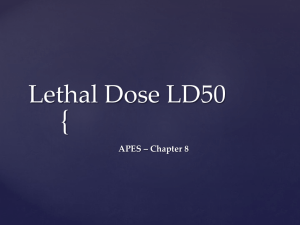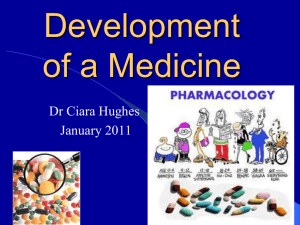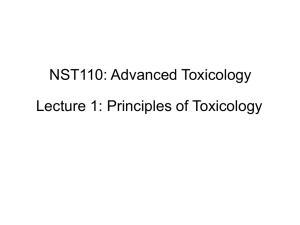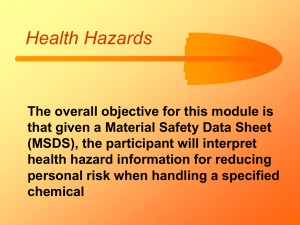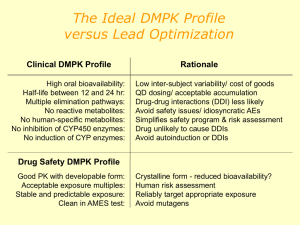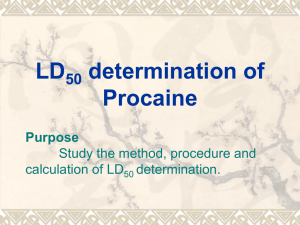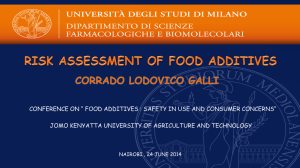Environmental Health and Toxicology
advertisement
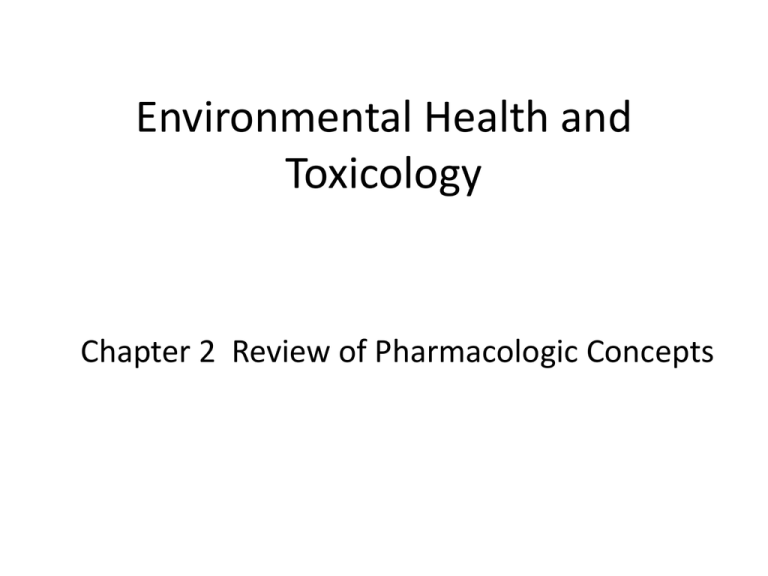
Environmental Health and Toxicology Chapter 2 Review of Pharmacologic Concepts Food vs Poison A long time ago, we believed there are only two basic types of substances: • Beneficial 有益 one (foods and medicines); • Harmful 有害one (causing sickness and death and called poisons) Today, modern science states that all substances have a whole spectrum 大范围of activities, ranging from beneficial to neutral to lethal 致命. “the right dose differentiates 区分a poison and a remedy 救药 ” Dose Response Relationship A famous admonitions 劝告 in toxicology “In all things there is a poison, and there is nothing without a poison. It depends only upon the dose whether a poison is poison or not.” Paracelsus (1493 – 1541) Determination of Toxicity Biological systems used, for example: • Growth inhibition抑制生长 of a cell 细胞 culture 培养液 • Mutagenesis突变形成, • Bacterial colony counter菌落计算器 • Death of an animal, eg. mouse, insects, etc. ** end points chosen depend on the goal of the experiment. Dose-response relationships • Intoxication process is mass-driven (the higher the dosage, the bigger the response) • chemicals absorbed per time • amount to reach target site (organs) • exposure (oral, skin) • toxic effects (individual variation) Calculation parameters Toxicity of a chemical is related to: • Size of the organism exposed; – Units per kilogram of body weight or per square meter of body surface area. – Eg. mouse vs. rat; kid vs. adult • Dose in terms of concentration 浓度, not mass – mass unit per volume(g/mL), or in molar units (molarity, eg 3 M) % Response vs dose, mg/kg • Cumulative 累积dose-response curve • S-shaped curve • At very low dose, biodegradation 生物降解or elimination 自动排泄dominate主要支配 – no response in organism • The highest dose that still produces no response is NOEL (No Observable 观察Effect Level) • The lowest dose to give the response is termed Toxic Threshold 门槛. Lethal dose 致命量 • Lethal dose or lethal concentration – at which the response of the test animals is death • If the response is a non-lethal response, the dose is termed as effective dose (ED) or sometimes call a toxic dose (TD) Other Terms • NOELs (no observable effect level) exist for any chemicals – Proven by the natural toxicants that make up our daily diet. • LD50 – at this concentration, 50% of test organisms die Response frequency % vs Dose • Each individual 个体 organism is toxicologically distinctive 独特because of variations变化 in its absorption, metabolism and response. • For a given dose, some variation in response is expected 期望. • Bell-shaped 铃 curve of normal probability 或然率 • Hypersensitive 反应过敏organisms respond at the low dose end and resistant organisms at the other. Response frequency % vs Dose, mg/kg 敏感 顽强 Probability vs cumulative (log对数) dose The dose-response relationship is linear 直线. The probability point at 50% response is the median, and the corresponding dose is median effective 有效 dose (ED50) If the response is death, the ED50 becomes the median lethal dose (LD50) LD50 of a chemical – is the dose will kill a statistical 50% of a test population. Toxicity of a chemical varies amongst species due to different size, metabolic ability and exposure condition. Probability vs cumulative (log) dose Potency 效力of a compound • The compound with the smaller LD50 value is the more potent one. • Some may have a reversed 反向toxicity relationship as LD value vary. – Refer to curve – A is more toxic than compound B at the LD50 concentrations, but less toxic at the LD20 concentrations. Potency of a compound Margin 边缘 of safety • Slope 倾斜度 is steep 陡峭– a small increase in the dose may produce a significant 明显change in toxicity. • The shallower the slope, the greater is the margin of safety. • ** this expression is NOT the same as therapeutic 治疗index 指数(LD50/ED50) in clinical 临床toxicology, where the margin of safety represents a spread between an effective dose ED50 and a toxic dose LD50 Biphasic 两阶段dose-response curve of chemicals • Happens in those organism that requires small amounts of the chemical for the normal 正常 functioning 活动, and yet at high concentration produce toxicity, e.g. vitamin A, niacin (vit B), selenium硒, and some heavy metals such as copper and cobalt . • Concentrations higher than the normal range cause toxicity. If the concentration is lower than the normal range, the organism suffers from a deficiency 缺乏 that alters normal functions. Biphasic dose-response curve of chemicals Factors affecting quantitative response • The duration of exposure – Acute toxicity – exposure to single dose over a short period of time (24-96h) – Acute toxicity is greater (LD50 is smaller) upon subacute 亚急性(a few days) or chronic (longer-term) • Absorption route – Respiratory exposure produces the highest toxicity – Dermal exposure is lower toxicity than oral exposure Other factors • Presence of impurities – Synergism 合作– toxicity of the mixtures is greater than the sum of the individual toxicities, e.g. inhibition 抑压 of the detoxification 解毒 of other eg. Alcohol + sleeping pills – Antagonism 对抗– toxicity of the mixtures is less than the sum of the individual toxicities, e.g. interfere the other’s receptor eg. Alcohol + rice Toxicokinetics毒代动力学 • Initial 初段 absorption – can be rapid快速 • Equilibrium 平衡 is reached – When intake = metabolism + elimination • Stop exposure --- decline in body content • Re-exposure 再接触--- new equilibrium will be established again. Toxicokinetics Basline=底线 uptake=吸入 equilibrium= 平衡 depuration=排毒 Reversibility 可逆性 of Toxicity • In most cases, toxicity induced 引发 by a chemical is essentially 实质上reversible; • Individual will recover 康复 when the toxin is removed by excretion 排泄 or inactivated 阻止活性 by metabolism 生陈代谢; • Sometimes toxicity is irreversible不可逆性, when the organs have been damaged too far, enzyme 酶is irreversibly inactivated; • Toxin may deprive 剥夺an organism of a vital 重要 substance, and recovery has to await 等待 resynthesis 重新制造of this substance. Concept of Receptors 受体 • Some chemical nonspecifically 不明确地denature 改 变本性 protein蛋白质, dissolve the tissue 组织 chemical burns; • Some toxins interact 互相影响with specific components of the tissue, thus perturbing 扰乱 normal metabolism; i.e. the concept 槪念 of receptors. • Receptors are proteins. Some have enzymatic activity and some serve as “transport vehicles媒介” across the cellular membranes 细胞膜. • Some plasma proteins 血蛋白 may not act as specific receptors, but act as a binding 粘结protein of chemicals. Xenobiotics外来物 is a general designation of chemical compounds foreign to the organism Mode模式 of Entry of Toxins 1. Percutaneous route (skin) 2. Repiratory route (breathing) 3. Oral route (eating or drinking) 循环系统 Circulatory System Extracellular細胞外 interstitial fluid 组织液 Percutaneous (skin) Route • Important route for human and animal exposure to environmental toxic chemicals; • Three possible routes of skin absorption: – Diffusion 扩散 through the epidermis 表皮into the dermis真皮 – Entry through sweat ducts汗腺; – Entry along the hair-follicle毛囊orifices 孔 • Outermost 最外边 layer of epidermis (Stratum corneum) is made up of several layers of dried, flattened keratinocytes 角质化细胞, no vascularization 血管分布, no metabolic 新 陈代谢activity • Lower basal layer of epidermis has high metabolic activity and is capable of biotransformation 生物转换of xenobiotics Percutaneous route • All entry of substances occurs by passive 被动 diffusion; • Polar 极性substances via the protein filaments and nonpolar substances via the lipid matrix基体; • Hydration 水合作用of the stratum corneum 角质层 increases its permeability 浸透for polar substances; • pH of the solution applied to the skin affects permeability; • Pretreatment 预先处理of the skin with e.g. dimethyl sulfoxide, methanol, ethanol, hexane, acetone, in particular a mixture of chloroform and methanol increase the permeability of the skin. • Permeability of skin is not uniform统一 • Percutaneous absorption is a time-dependent process, with passage through the stratum corneum as the rate-limiting reaction. Respiratory Route • Respiratory system consists of three regions: – Nasopharyngeal鼻咽 – Tracheobronchial气管与支气管 – Pulmonary肺部 • Nasopharyngeal canal is lined by ciliated 纤毛epithelium through which mucous glands粘液腺 are scattered分散. – The role is to remove large inhaled particles and to increase the humidity and temperature of inhaled air • Tracheobronchial region consists of the trachea, bronchi, and bronchioles 细支气管 – These are branched between the nasopharyngeal and pulmonary regions; – Lined with ciliated epithelium and mucus-secreting goblet cells杯状细 胞 – Propel 驱使 foreign 外来 particles from the deep parts of the lungs to the oral 口腔 cavity, either expelled 排出with the sputum 痰 or swallowed吞下. Respiratory Route • Pulmonary region consists of respiratory bronchioles, alveolar ducts肺泡管, and clusters 群 of alveoli; – Alveoli – as little bubbles about 150-350 µm in diameter, for the gaseous exchange between the environment and the blood – Total alveolar surface area of human lung is 35 m2 during expiration 排气 and 100 m2 during deep inhalation深呼吸. – Toxins exert their harmful action either by damaging respiratory tissue or by entering the circulation and causing systemic 全身toxicity. • The amount of a toxin delivered to the lungs depends on the concentration of the toxin in the air and on the minute volume of respiration – Minute volume is a product of tidal volume潮气量 and the number of breaths 呼吸per minute. Respiratory Route Fick’s law D = Cd x S/MW-1/2 x A/d x (Pa- Pb) D: diffusion rate; Cd: diffusion coefficient; S: solubility of the gas in blood; MW: molecular weight; A : surface area; d: thickness of the membrane; Pa and Pb: partial 部分pressure of the gas in the inspired 吸入air and in the blood. Respiratory Route Toxicity depends on the size of the particles: • Particles larger than 5 µm – Deposit in nasopharyngeal region, expelled 排出 by sneezing 喷嚏or propelled into the oral cavity. • Particles 2-5 µm in size – Deposit in tracheobronchial region, cleared by the mucociliary escalator电动扶梯, expelled in the sputum or swallowed • Particles 1 µm or smaller – Deposit in alveoli, removed by mucociliary escalator, or enter lymphatic system淋巴系统 Oral route • Mouth and esophagus食道 – Short retention time停留时间, no significant absorption • Stomach 胃 (gastric acid 胃酸) – Toxicity can be altered 改变 by influencing影响 absorption or modifying修改 the chemicals • Depend upon whether compounds are administered 加 入 with food or directly into the empty stomach Oral Route • Small Intestine 小肠 – Most food absorption takes place – Xenobiotics (foreign chemicals外来化学品) may enter the body via the carrier systems for nutrients or via passive diffusion – Lipid-soluble organic acids and bases are absorbed by passive diffusion only in nonionized form. – Particles of several nanometers 纳米in diameter can be absorbed from the gastrointestinal tract by pinocytosis胞饮作 用 and enter the blood circulation 血液循环via the lymphatic system – Absorbed compounds may enter the circulation either via the lymphatic system, then to blood, or via the portal circulation 肝 静脉 to liver. Translocation移动 of Xenobiotics • Absorbed xenobiotics must be transported by the blood before reaching the target 目标cells • The time to the onset of toxicity depends on how quickly plasma levels of the toxic compound may be achieved. • The capillary walls have pores 毛孔of up to 0.003 µm (3 nm纳米)in diameter between them. • The water-soluble compounds of up to 60,000 molecular mass enter and exit the bloodstream by filtration 过滤through these pores. • The velocity 速度of diffusion decreases rapidly with increasing molecular radius半径. Translocation of Xenobiotics • Lipophilic 嗜油脂compounds diffuse easily through capillary walls. • Their diffusion velocity is related to their lipid-water partition coefficient. • The entry of a compound into the blood does not necessarily ensure it will arrive unchanged at its target site. – Inactivated in liver, excreted into the bile and returned to the gastrointestinal tract – Could be reabsorbed and back to the liver – called enterohepatic circulation肠肝循环 • Blood plasma has a limited metabolic capacity, involving hydrolytic and transaminating enzymes • Some xenobiotics may be temporarily inactiviated by bounding to plasma 血浆 protein. Cellular 细胞的 Uptake吸入 • According to the fluid 流体mosaic model流体镶嵌模型, the plasma membrane consists of two layers of lipids with their hydrophobic疏水性 ends facing each other. • The hydrophilic亲水的 ends face the aqueous environment of the interstitial 空隙 fluid on one side and the interior of the cell on the other side. • Two types of proteins are embedded into this structure. – Peripheral proteins do not penetrate through the membrane and can be removed without disrupting 使混乱 its integrity完整性. – Integral 完整proteins extend 延伸across the width of the membrane, responsible for the transport of compound across it. Cellular Uptake Four mechanisms of passage through the cell membrane: • Water and small organic and inorganic molecules diffuse through the small pores in the membrane (0.2-0.4 nm) • Lipid-soluble molecules diffuse easily through the lipid bilayer in the direction of the concentration gradient浓度梯度 (from high concentration to low concentration). • Transported across the membrane by specialized enzymatic processes that exhibit saturation kinetics – Energy-independent, transport occurs in the direction of the concentration gradient, called facilitated diffusion – Require energy input, transport occurs against 相反the concentration gradient, called active transport主动运输 (energy required) Distribution 分布 between plasma 血浆 and tissue 组织 (Pharmacokinetics药代动力学 ) • Solutes are freely 自由exchangeable交换 between plasma and the interstitial fluid, thus the concentration of a xenobiotic in tissue is proportional to that of the free xenobiotic in plasma. • The proportionality factor is expressed in terms of an apparent volume of distribution (VD) • Large VD indicates easy uptake吸收, whereas a small VD indicates poor uptake of a compound by the tissue • However, the true picture is complicated 复杂by the binding of a xenobiotic to plasma protein or its deposition 排到 in fat脂肪. Distribution Between Plasma and tissue e.g. animal is injected intravenously 静脉注射 with chemicals: • Concentration of the compound in plasma is determined at frequent time intervals • The peak concentration occurs immediately after the injection • Concentration decrease with time through two processes: uptake by tissue (αphase) and elimination from plasma (βphase) • Elimination include urinary excretion, fecal excretion, excretion by exhalation, excretion with sweat, or metabolism. Distribution between plasma and tissue • Plasma clearance清除 – Represents the volume of blood plasma cleared of a xenobiotic in one minute • Blood-brain barrier血脑屏障 – Related to impaired 受损 permeability of the blood capillaries毛细管 in brain tissue – Lipid solubility of a toxin is an important factor in the penetration 穿透of the blood-brain barrier Storage储藏 of Chemicals in the Body • In general, a compound will accumulate 累积 in the body after repeated intake if its elimination or biotransformation 生物转化 is slower than the frequency of uptake. • Some compounds are stored in the body in specific tissues. Such storage effectively removes the material from circulation and thus decreases the toxicity of the compound. • Repeated doses of a toxic substance may be taken up and subsequently stored without apparent toxicity until the storage receptors become saturated; toxicity suddenly occurs. E.g. lipophilic compounds such as halogenated hydrocarbons DDT (dichlorodiphenyltrichloroethane), PCBs (polychlorinated biphenyls), etc. stored in fat without apparent harm to the exposed organism. Accumulate in the food chain食物链 . Eventually, the storage capacity 容量of an organism at the end of the food chain may be exceeded超过. Toxin may be released into circulation and causing harmful effects. During starvation饥饿, fat deposits are mobilized for energy. Stored toxins are then released, causing sickness or death
